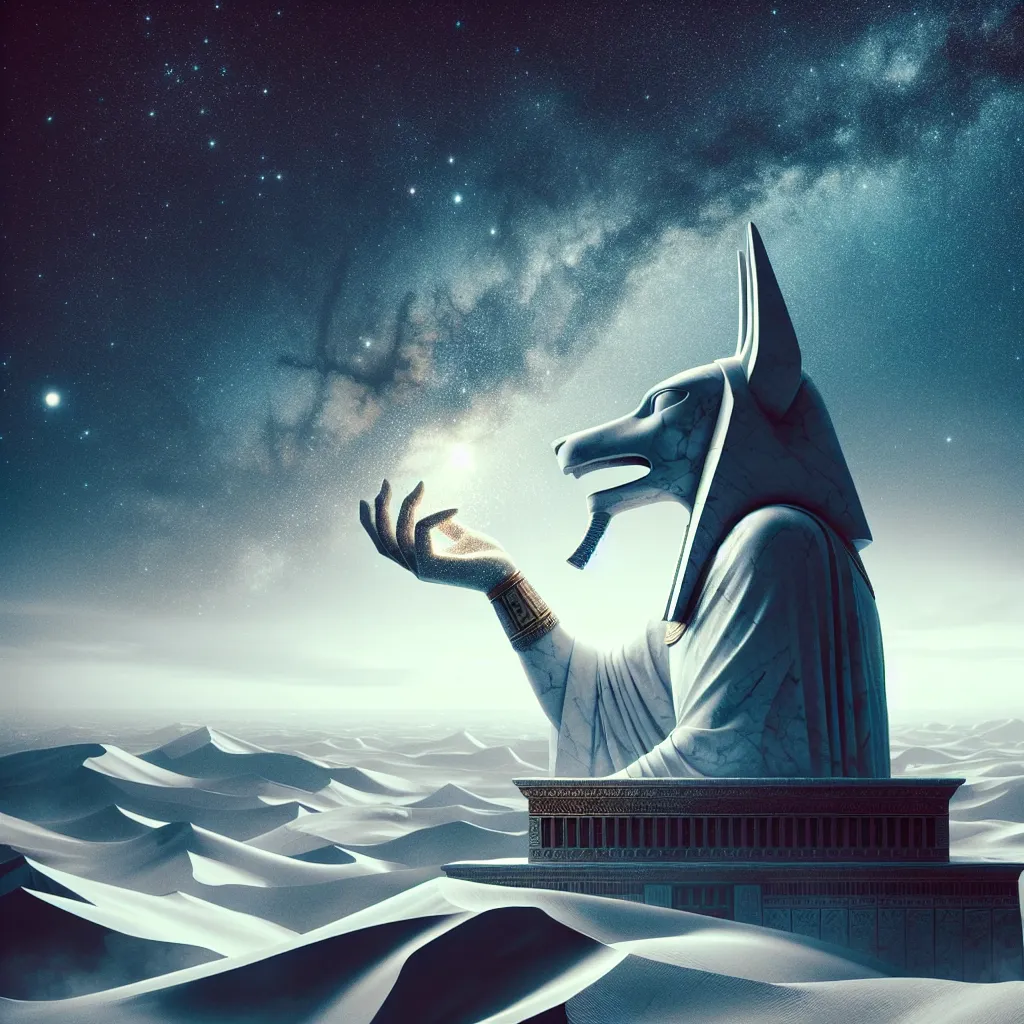
- Published on
- Authors

- Name
- You
The Breath of Anubis: Protection and Guidance in the Afterlife
Introduction
In ancient Egyptian mythology, Anubis is a significant figure, known as the god of mummification and the afterlife. His role extends beyond mere embalming; he is a protector and guide for souls journeying through the afterlife. Central to Anubis's role is the mystical concept of breath, which symbolizes life, protection, and spiritual continuity.
Anubis: The God of Mummification and Afterlife
Anubis, often depicted with a jackal head, is a deity deeply intertwined with death and the processes following it. He was responsible for the embalming of Osiris, and by extension, he became associated with mummification practices. His responsibilities include:
- Embalming the Dead: Anubis ensured that the bodies were properly preserved for the afterlife.
- Weighing of the Heart: He oversaw the crucial heart-weighing ceremony against the feather of Ma'at, determining the soul’s fate.
- Protection of Tombs: Anubis safeguarded tombs and the buried, deterring grave robbers and desecration.
The Mystical Significance of Breath
In Egyptian mythology, breath is more than a mere survival mechanism; it represents the essence of life and continuity. The ancient Egyptians believed that the breath, or "ka," was an essential element of life that continued into the afterlife.
Breath in Mummification
The process of mummification was not just physical preservation but a sacred ritual to ensure the continuation of the "ka." Anubis’s role was to protect this breath of life, sealed within the preserved body, ensuring its safe passage to the afterlife.
| Aspect of Breath | Role in Rituals | Symbolism |
|---|---|---|
| Ka | Vital essence | Life force, spirit |
| Ba | Personality and mobility | Spiritual mobility |
| Akh | Transformed state | Eternal, unending life |
Anubis as a Protector and Guide
Protector of the Tomb
Anubis's jurisdiction over tombs extended to the metaphysical protection of the deceased. The breath, preserved through mummification, required safeguarding against spiritual harm as well as corporeal threats. Anubis’s presence was invoked to ensure this protection.
Guide in the Afterlife
Protection naturally extended to guidance. Anubis was believed to assist souls navigating the Duat (the underworld), offering wisdom and protection against malevolent entities. The preservation of the breath through mummification provided the necessary vitality for the soul’s journey.
Modern Scientific Perspectives
While mystical interpretations dominated ancient beliefs, modern science interprets these practices with a different lens. Mummification, from a scientific standpoint, preserved the body through techniques that prevented decay. However, the significance attributed to breath highlights an early understanding of its life-sustaining power, paralleling modern notions of air and respiration.
Bridging Mysticism and Science
The relationship between Anubis and the breath in ancient rituals offers a unique intersection of mysticism and early scientific principles. The rituals encoded a sophisticated understanding of preservation techniques, where mystical interpretations filled in the gaps left by empirical understanding.
Scientific Insights on Preservation
Table of Mummification Techniques:
| Technique | Description | Scientific Basis |
|---|---|---|
| Desiccation | Removing moisture to prevent decay | Inhibits bacterial growth and decomposition |
| Natron Usage | Application of natural salts | Absorbs moisture, antimicrobial properties |
| Evisceration | Removal of internal organs | Reduces decomposition vectors |
Conclusion
Anubis, as the god of mummification and the afterlife, embodies a blend of mystical wisdom and what could be considered proto-scientific practice. The centrality of breath in his protective and guiding functions underscores its profound importance in both ancient and modern contexts. This intersection offers a holistic view of life, death, and the continuity of the spirit, making Anubis not only a guardian of the dead but also a timeless figure bridging the gap between the physical and the metaphysical realms.
Further Reading
- "The Oxford Handbook of the Egyptian Book of the Dead" by Associate Professor Rita Lucarelli
- "Ancient Egyptian Magic" by Bob Brier
- "The Complete Gods and Goddesses of Ancient Egypt" by Richard H. Wilkinson
